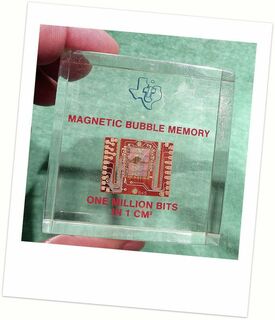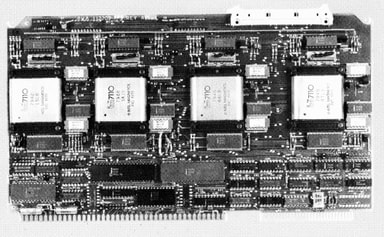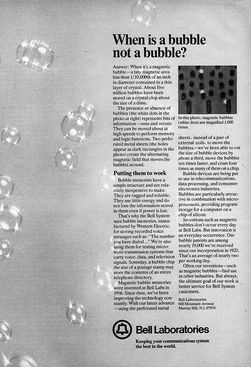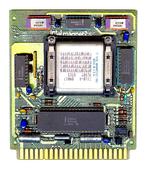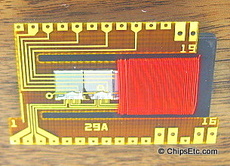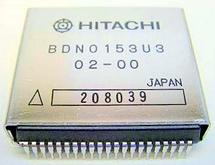
Texas Instruments bubble memory module (1977)
The concept of bubble memory, a new form of non-volatile solid-state memory, was first introduced by Andrew Bobeck in 1967 while working at Bell Telephone Laboratories.
Bubble memory technology used a thin film of magnetic material deposted onto a slice of garnet. On the surface of the film there were small magnetized areas known as bubbles. Each bubble was capable of storing one bit of data.
Bubble memory started out as a promising new data storage technology in the 1970's. It was promoted as being a faster, cheaper, and more reliable replacement to conventional mini-floppy and Winchester disk storage devices.
Bell telephone would implement Bubble memory in some of their phone system equipment, including digital storage of phone voice messages. The first real use of Bubble memory was by Bell Telephone in 1977 for their 13A digital recording and playback machine that would announce messages to phone user's ("the number you have reached is no longer in service").
In the late 1970's, Bubble memory modules manufactured by Rockwell International were being used in flight data recorders as a more survivable form of storing avionics data, replacing out- dated electromechanical tape recorders.
Intel, Western Electric, Texas Instruments, Rockwell, National Semiconductor, Hitachi, Westinghouse, Motorola, Fujitsu & Sharp all competed to commercially produce bubble memory modules during the late 1970's.
In 1979, Intel Magnetics Inc. (a division Intel founded in 1977) would introduce the first commercially available 1-megabit Bubble memory called the Intel 7110. It could store up to 128K of data. The Intel iSBX-251 bubble memory card was introduced in 1981 for use with their microprocessor-based Intel single-board computers.
Bubble memory also found it's way into a few portable computers in 1982, such as the Compass Computer from GRiD, and the Teleram 3000 portable computer from Teleram Communications Corp, both using Intel's 7110 1-megabit bubble memory modules.
In 1982, a company called MPC released a Bubble memory card for the Apple II computer that allowed it to be used as a portable computer. The card also used an Intel 7110, 1-megabit Bubble memory. Apple DOS command execution times were reported to be 3 to 5 times faster than when using an Apple Floppy disk drive.
Prices of Bubble memory, per bit of storage capacity, remained high and never fell below the prices of floppy disk drives. Hard disk computer storage prices also fell rapidly in the 1980's which led to the end of bubble memory being competitive in the commercial computer market. Bubble memory would mostly be used in more advanced applications such as in aerospace and military applications, including Air Force fighters aircraft, flight data recorders and satellites.
Texas Instruments, National Semiconductor, and Rockwell International would all exit the Bubble memory business in 1981. Intel would be one of the last to exit the bubble memory business, selling their Intel Magnetics division off to a company called MemTech in 1986.
Bubble memory technology used a thin film of magnetic material deposted onto a slice of garnet. On the surface of the film there were small magnetized areas known as bubbles. Each bubble was capable of storing one bit of data.
Bubble memory started out as a promising new data storage technology in the 1970's. It was promoted as being a faster, cheaper, and more reliable replacement to conventional mini-floppy and Winchester disk storage devices.
Bell telephone would implement Bubble memory in some of their phone system equipment, including digital storage of phone voice messages. The first real use of Bubble memory was by Bell Telephone in 1977 for their 13A digital recording and playback machine that would announce messages to phone user's ("the number you have reached is no longer in service").
In the late 1970's, Bubble memory modules manufactured by Rockwell International were being used in flight data recorders as a more survivable form of storing avionics data, replacing out- dated electromechanical tape recorders.
Intel, Western Electric, Texas Instruments, Rockwell, National Semiconductor, Hitachi, Westinghouse, Motorola, Fujitsu & Sharp all competed to commercially produce bubble memory modules during the late 1970's.
In 1979, Intel Magnetics Inc. (a division Intel founded in 1977) would introduce the first commercially available 1-megabit Bubble memory called the Intel 7110. It could store up to 128K of data. The Intel iSBX-251 bubble memory card was introduced in 1981 for use with their microprocessor-based Intel single-board computers.
Bubble memory also found it's way into a few portable computers in 1982, such as the Compass Computer from GRiD, and the Teleram 3000 portable computer from Teleram Communications Corp, both using Intel's 7110 1-megabit bubble memory modules.
In 1982, a company called MPC released a Bubble memory card for the Apple II computer that allowed it to be used as a portable computer. The card also used an Intel 7110, 1-megabit Bubble memory. Apple DOS command execution times were reported to be 3 to 5 times faster than when using an Apple Floppy disk drive.
Prices of Bubble memory, per bit of storage capacity, remained high and never fell below the prices of floppy disk drives. Hard disk computer storage prices also fell rapidly in the 1980's which led to the end of bubble memory being competitive in the commercial computer market. Bubble memory would mostly be used in more advanced applications such as in aerospace and military applications, including Air Force fighters aircraft, flight data recorders and satellites.
Texas Instruments, National Semiconductor, and Rockwell International would all exit the Bubble memory business in 1981. Intel would be one of the last to exit the bubble memory business, selling their Intel Magnetics division off to a company called MemTech in 1986.
